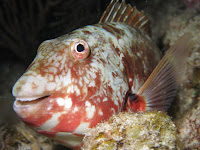CENOTES
The term derives from a word used by the low-land Yucatec Maya —
ts'onot — to refer to any location with accessible groundwater. Cenotes are common geological forms in low latitude regions, particularly on islands, coastlines, and platforms with young post-
Paleozoic limestones that have little soil development.
Formation

Cenotes are formed by dissolution of rock and the resulting subsurface void, which may or may not be linked to an active
cave system, and the subsequent structural collapse. Rock that falls into the water below is slowly removed by further dissolution, creating space for more collapse blocks. The rate of collapse increases during periods when the
water table is below the ceiling of the void, since the rock ceiling is no longer buoyantly supported by the water in the void.
Cenotes may be fully collapsed creating an open water pool, or partially collapsed with some portion of a rock overhanging above the water. The stereotypical cenotes often resemble small circular
ponds, measuring some tens of meters in diameter with sheer drops at the edges. Most cenotes, however, require some degree of stooping or crawling to access the water.
Penetration and extent
In the north and northwest of the
Yucatán Peninsula, the cenotes generally overlie vertically extensive voids penetrating 50 to 100 m (160 to 330 ft) below the modern water table. However, very few of these cenotes appear to be connected with horizontally extensive underground river systems, with water flow through them being more likely dominated by aquifer matrix and fracture flows. In contrast, the cenotes along the Caribbean coast of the Yucatán Peninsula (within the state of
Quintana Roo) often provide access to extensive underwater cave systems, such as
Sistema Ox Bel Ha,
Sistema Sac Actun/
Sistema Nohoch Nah Chich and
Sistema Dos Ojos.
Freshwater/seawater interface
The Yucatán Peninsula contains a vast coastal
aquifer system, which is typically density-stratified.
[5] The infiltrating
meteoric water (i.e., rainwater) floats on top of higher-
density saline water intruding from the coastal margins. The whole aquifer is therefore an
anchialine system (one that is land-locked but connected to an ocean). Where a cenote, or the flooded cave to which it is an opening, provides deep enough access into the aquifer, the interface between the fresh and saline water may be reached. The density interface between the fresh and saline waters is a
halocline, which means a sharp change in salt concentration over a small change in depth. Mixing of the fresh and saline water results in a blurry swirling effect caused by
refraction between the different densities of fresh and saline waters.
The depth of the halocline is a function of several factors: climate and specifically how much meteoric water recharges the aquifer,
hydraulic conductivity of the host rock, distribution and connectivity of existing cave systems and how effective these are at draining water to the coast, and the distance from the coast. In general, the halocline is deeper further from the coast, and in the Yucatán Peninsula this depth is 10 to 20 m (33 to 66 ft) below the
water table at the coast, and 50 to 100 m (160 to 330 ft) below the water table in the middle of the peninsula, with saline water underlying the whole of the peninsula.
[5]
Types
Radar topography reveals the 180 km (110 mi) ring of the crater; clustered around the crater's trough are numerous sinkholes, suggesting a prehistoric oceanic basin in the depression left by the impact (Image courtesy NASA/JPL-Caltech).
In 1936, a simple morphometry-based classification system for cenotes was presented.
- Cenotes-cántaro (Jug or pit cenotes) are those with a surface connection narrower than the diameter of the water body;
- Cenotes-cilíndricos (Cylinder cenotes) are those with strictly vertical walls;
- Cenotes-aguadas (Basin cenotes) are those with shallow water basins; and
- grutas (Cave cenotes) are those having a horizontal entrance with dry sections.
The classification scheme was based on morphometric observations above the water table, and therefore incompletely reflects the processes by which the cenotes formed and the inherent hydrogeochemical relationship with the underlying flooded cave networks, which were only discovered in the 1980s and onwards with the initiation of cave diving exploration.




















